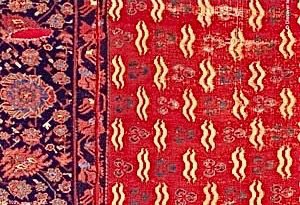Chintamani
Chintamani is a Sanskrit word for a wish fulfilling gem in Hindu and Buddhist culture. The motif featuring wavy lines (reminiscent of tiger stripes or cloud bands) with three circles (pearls of wisdom) appears on Turkish rugs and textiles found from goods traded on the Silk Road.
Chintamani became an “official” symbol of the Ottoman courts when adopted by Sulieman the Magnificent, the 10th Ottoman emperor. Under his rule only members of the royal court could wear the symbol. The symbol was worn by both men and women of the court and often woven with metallic thread, making Chintamani a status symbol.
Silk velvet with silver metallic brocade
Antique Oushak carpet 16th century from The Museum of Turkish & Islamic Arts, Sultanamet Istanbul
16th century textile with large Chintamani via The Met Museum
17th century Turkish Anatolian rug made of wool and goat hair
Ottoman Medallion carpet via Museum of Fine Arts, Budapest Hungary
Chintamani Kilim
Available at PAO
Caftan of red silk with appliqués of gold crescents and tulips

















